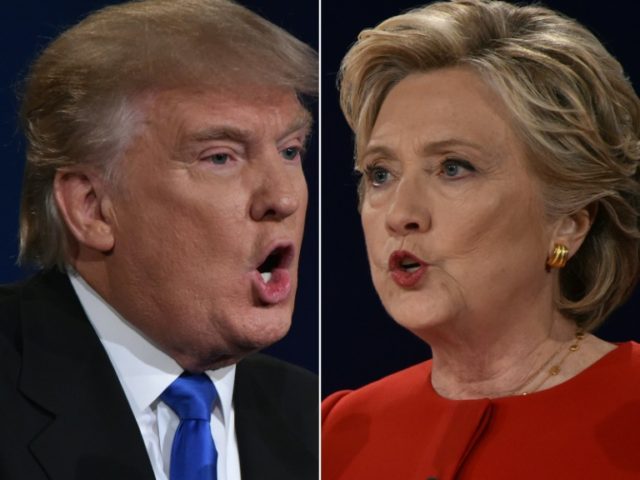Hillary Clinton’s lead over Donald Trump in Michigan dropped to five points in one Michigan poll, while it increased to thirteen points in another poll.
A statewide poll conducted by the Marketing Resource Group showed “Hillary Clinton continues to lead Donald Trump by five percentage points (41 percent – 36 percent) in Michigan as the campaign for President enters the final few weeks of the election. The statewide poll, conducted by Marketing Resource Group (MRG), showed the number of undecided voters has been reduced to just eight percent.”
The poll of 600 likely voters was conducted by live interview between October 16 and October 19 (the date of the third and final presidential debate) and has a margin of error of plus or minus four percent.
Another poll “of Michigan shows former Secretary of State Hillary Clinton leading businessman Donald Trump by a 13 percent margin in a four-way race that includes Libertarian Party candidate former New Mexico Gov. Gary Johnson and Green Party candidate Dr. Jill Stein. In the four-way race it is Clinton 51% -Trump 38% -Johnson 6% -Stein 2%, and 3% undecided. In a two-
way race it is Clinton 53% -Trump 41% with 6% undecided.”
“The IVR (automated) poll of 1,102 likely voters in the November 2016 General Election was conducted by Mitchell Research & Communications on October 18, 2016 and has a margin of error of + or – 2.95% at the 95% level of confidence,” Fox 2 in Detroit reported.
“Clinton’s lead has increased in the past week and she is in a strong position going into the last debate tonight. Trump will have to do a great job, or Clinton will have to make a big mistake to change the trajectory of this race in Michigan,” Steve Mitchell of Mitchell Research & Communications told Fox 2 just prior to the third and final presidential debate.
Two focus groups of undecided voters said Trump won the debate, while several post-debate polls showed Clinton winning the debate.
Tom Shields, President of MRG whose poll shows Clinton’s lead has shrunk to five points, has a different opinion on the positioning of the two candidates.
“Either candidate can win Michigan by winning votes back from the third party candidates and capturing a majority of the 15 percent of the Independent voters who are still undecided. This is coming down to a traditional election where the Independent voters will decide who wins Michigan,” he said in a statement.
“Neither candidate is popular,” the MRG statement about the poll says:
Neither candidate has gained in popularity since MRG’s last poll in July. A majority of Michigan voters has a negative view of both Clinton (31 percent favorable/58 percent unfavorable) and Trump (29 percent favorable/60 percent unfavorable) when voters were asked their perceptions of each candidate.
The Mitchell Research Poll that shows Clinton increased her lead in Michigan to thirteen points found, “in terms of demographics”:
Clinton’s 17 percent lead (53%-36%) with women is almost identical to her 18 percent lead a week ago, while Trump now trails with men by 9 percent (49%-40%).
Clinton leads by 25 percent with 18-44 year old voters (55%-30%) with 9% of that age group voting for Johnson, and 3% for Stein. Clinton leads with 45-64 year olds (46%-44%) and with 65 + voters (54%-40%). Trump had strong gains among 45-64 year olds but had a big drop with 18-44 year olds.
By race, Clinton leads with whites (48%-46%), African-Americans (80%-16%) and with other ethnic groups (61%-31%).
By area, Clinton leads in the city of Detroit (82%-12%), in the Tri-County area (53%-41%) and even Outstate (48%-45%).
Other key findings:
.
Both Clinton (46% Favorable-48% Unfavorable) and Trump (33%-61%) are unpopular.However, for the first time, Clinton’s unfavorable is below 50 percent.
.
More people say jobs/economy (56%) is the most important issue in the presidential campaign than say national defense/terrorism (32%). Twelve percent are undecided.
The MRG Poll’s demographic analysis also shows Clinton leading with women and African-American voters by similar margins, but differs from Mitchell Research, showing a narrower Clinton lead in Detroit, and Trump leading in other areas of the state:
The poll showed that Clinton’s lead is directly attributed to her strong amount support from women, where she leads Trump by 16 percent, and her amount of support from African American voters where she leads by 80 percent (84 percent Clinton – 4 percent Trump). Trump is winning among men by 5 percent. He also leads among white voters by 5 percent.
Both candidates have solidified their base party vote with 78 percent of all Democrats voting for Clinton and 77 percent of Republicans voting for Trump. Independent voters favor Trump over Clinton by 7 percent. Neither candidate is attracting members of the opposite party as only 4 percent of Republicans are voting for Clinton and 5 percent of Democrats are voting for Trump.
Geographically, Clinton’s strongest support comes from the Detroit metropolitan area where she leads Trump 46 percent to 34 percent. Trump leads Clinton in the Grand Rapids/West Michigan area by 5 percent (40 percent Trump – 35 percent Clinton) and in the Traverse City/Northern Michigan area by 15 percent (41 percent Trump to 26% Clinton).
Real Clear Politics lists Michigan as “Likely Clinton.” The Real Clear Politics average of polls currently gives Clinton a 10 point advantage over Trump in the state, and includes the results of both the MRG poll and the Mitchell Research Poll.

COMMENTS
Please let us know if you're having issues with commenting.